Carbon Nanotube Field Emitters Synthesized on Metal Alloy Substrate by PECVD for Customized Compact Field Emission Devices to Be Used in X-Ray Source Applications
Abstract
:1. Introduction
2. Materials and Methods
3. Results and Discussion
3.1. CNT Emitter for Compact Field Emission Device
3.2. Raman Spectrum of PECVD Sythensized CNT
3.3. Field Emission Measurment Using Compact Field Emission Device
3.4. X-ray Image Acqusition Using Compact Field Emission Device Embedded in Conventional Electron Gun
4. Conclusions
Author Contributions
Acknowledgments
Conflicts of Interest
References
- De Heer, W.A.; Chatelain, A.; Ugarte, D. A carbon nanotube field-emission electron source. Science 1995, 270, 1179–1180. [Google Scholar] [CrossRef]
- Liu, Z.; Yang, G.; Lee, Y.Z.; Bordelon, D.; Lu, J.; Zhou, O. Carbon nanotube based microfocus field emission X-ray source for microcomputed tomography. Appl. Phys. Lett. 2006, 89. [Google Scholar] [CrossRef]
- Read, M.; Kremer, M.; Schwarz, W.; Lennhoff, J.; Carnahan, D.; Ren, Z. Carbon nanotube-based cathodes for microwave tubes. IEEE Int. Conf. Plasma Sci. 2001, 2, 1026–1028. [Google Scholar] [CrossRef]
- Wang, Q.; Wang, J.; Di, Y.; Lei, W.; Zhang, X.; Zhu, Z. Shadow mask field emission display with carbon nanotubes emitters. Diam. Relat. Mater. 2008, 17, 217–222. [Google Scholar] [CrossRef]
- Meyyappan, M.; Delzeit, L.; Cassell, A.; Hash, D. Carbon nanotube growth by PECVD—A review. Plasma Sources Sci. Technol. 2003, 12, 205–216. [Google Scholar] [CrossRef]
- Li, D.; Cheng, Y.; Wang, Y.; Zhang, H.; Dong, C.; Li, D. Improved field emission properties of carbon nanotubes grown on stainless steel substrate and its application in ionization gauge. Appl. Surf. Sci. 2016, 365, 10–18. [Google Scholar] [CrossRef]
- Zhu, W.; Zhang, Y.; Xu, N.; Tan, Y.; Zhan, R. Epitaxial growth of multiwall carbon nanotube from stainless steel substrate and effect on electrical conduction and field emission. Nanotechnology 2017, 28, 305704. [Google Scholar] [CrossRef] [PubMed]
- Hashempour, M.; Vicenzo, A.; Zhao, F.; Bestetti, M. Direct growth of MWCNTs on 316 stainless steel by chemical vapor deposition: Effect of surface nano-features on CNT growth and structure. Carbon N. Y. 2013, 63, 330–347. [Google Scholar] [CrossRef]
- Ryu, J.H.; Kim, W.S.; Lee, S.H.; Eom, Y.J.; Park, H.K.; Park, K.C. Vertically Aligned Carbon Nanotube Emitter on Metal Foil for Medical X-ray Imaging. J. Nanosci. Nanotechnol. 2013, 13, 7100–7103. [Google Scholar] [CrossRef] [PubMed]
- Yuan, X.; Cole, M.; Zhang, Y.; Wu, J.; Milne, W.; Yan, Y. Parametrically Optimized Carbon Nanotube-Coated Cold Cathode Spindt Arrays. Nanomaterials 2017, 7, 13. [Google Scholar] [CrossRef] [PubMed]
- Li, X.; Baker-Fales, M.; Almkhelfe, H.; Gaede, N.R.; Harris, T.S.; Amama, P.B. Rational Modification of a Metallic Substrate for CVD Growth of Carbon Nanotubes. Sci. Rep. 2018, 8, 4349. [Google Scholar] [CrossRef] [PubMed]
- Gupta, A.P.; Park, S.; Yeo, S.J.; Jung, J.; Cho, C.; Paik, S.H.; Park, H.; Cho, Y.C.; Kim, S.H.; Shin, J.H.; et al. Direct synthesis of carbon nanotube field emitters on metal substrate for open-type X-ray source in medical imaging. Materials 2017, 10, 878. [Google Scholar] [CrossRef] [PubMed]
- Puett, C.; Inscoe, C.; Hartman, A.; Calliste, J.; Franceschi, D.K.; Lu, J.; Zhou, O.; Lee, Y.Z. An update on carbon nanotube-enabled X-ray sources for biomedical imaging. Wiley Interdiscip. Rev. Nanomed. Nanobiotechnol. 2017, 1–11. [Google Scholar] [CrossRef] [PubMed]
- Basu, A.; Swanwick, M.E.; Fomani, A.A.; Velásquez-García, L.F. A portable X-ray source with a nanostructured Pt-coated silicon field emission cathode for absorption imaging of low-Z materials. J. Phys. D Appl. Phys. 2015, 48, 225501. [Google Scholar] [CrossRef]
- Li, Y.; Zhang, Z.; Zhang, G.; Zhao, L.; Deng, S.; Xu, N.; Chen, J. Optimizing the field emission properties of ZnO nanowire arrays by precisely tuning the population density and application in large-area gated field emitter arrays. ACS Appl. Mater. Interfaces 2017, 9, 3911–3921. [Google Scholar] [CrossRef] [PubMed]
- Zhu, N.; Chen, J. Design, fabrication and characterization of molybdenum field emitter arrays (Mo-FEAs). Micromachines 2017, 8, 162. [Google Scholar] [CrossRef]
- Urban, F.; Passacantando, M.; Giubileo, F.; Iemmo, L.; Di Bartolomeo, A. Transport and Field Emission Properties of MoS2 Bilayers. Nanomaterials 2018, 8, 151. [Google Scholar] [CrossRef] [PubMed]
- Sankaran, K.J.; Kunuku, S.; Leou, K.-C.; Tai, N.-H.; Lin, I.-N. Enhancement of the Electron Field Emission Properties of Ultrananocrystalline Diamond Films via Hydrogen Post-Treatment. ACS Appl. Mater. Interfaces 2014, 6, 14543–14551. [Google Scholar] [CrossRef] [PubMed]
- Di Bartolomeo, A.; Giubileo, F.; Iemmo, L.; Romeo, F.; Russo, S.; Unal, S.; Passacantando, M.; Grossi, V.; Cucolo, A.M. Leakage and field emission in side-gate graphene field effect transistors. Appl. Phys. Lett. 2016, 109. [Google Scholar] [CrossRef]
- Puett, C.; Calliste, J.; Wu, G.; Inscoe, C.R.; Lee, Y.Z.; Zhou, O.; Lu, J. Contrast enhanced imaging with a stationary digital breast tomosynthesis system. SPIE Med. Imaging 2017, 10132, 1013225. [Google Scholar] [CrossRef]
- Walker, B.J.; Radtke, J.; Chen, G.H.; Eliceiri, K.W.; Mackie, T.R. A beam optics study of a modular multi-source X-ray tube for novel computed tomography applications. Nucl. Instrum. Methods Phys. Res. A 2017, 868, 1–9. [Google Scholar] [CrossRef]
- Schreiner, R.; Langer, C.; Prommesberger, C.; Dams, F. Compact and Energy-Efficient Field Emission Cathodes for Sensor Applications. Adv. Mater. Res. 2014, 1024, 372–375. [Google Scholar] [CrossRef]
- Park, D.; Kim, Y.H.; Lee, J.K.E.E. Pretreatment of stainless steel substrate surface for the growth of carbon nanotubes by PECVD. J. Mater. Sci. 2003, 8, 4933–4939. [Google Scholar] [CrossRef]
- Wang, S.; Wang, P.; Zhou, O. Effects of NH3plasma pretreatment on the growth of carbon nanotubes. Diam. Relat. Mater. 2006, 15, 361–364. [Google Scholar] [CrossRef]
- Sun, Y.; Shin, D.H.; Yun, K.N.; Hwang, Y.M.; Song, Y.; Leti, G.; Jeon, S.G.; Kim, J.I.; Saito, Y.; Lee, C.J. Field emission behavior of carbon nanotube field emitters after high temperature thermal annealing. AIP Adv. 2014, 4. [Google Scholar] [CrossRef]
- Ren, Z.F.; Lan, Y.; Wang, Y. Aligned Carbon Nanotubes; Avouris, P., Bhusan, B., Bimberg, D., Klitzing, K.V., Sakaki, H., Wiesendenger, R., Eds.; Springer: Berlin, Germany, 2013; pp. 73–74. ISBN 978-3-642-30490-3. [Google Scholar]
- Di Bartolomeo, A.; Scarfato, A.; Giubileo, F.; Bobba, F.; Biasiucci, M.; Cucolo, A.M.; Santucci, S.; Passacantando, M. A local field emission study of partially aligned carbon-nanotubes by atomic force microscope probe. Carbon N. Y. 2007, 45, 2957–2971. [Google Scholar] [CrossRef]
- Kennedy, J.; Fang, F.; Futter, J.; Leveneur, J.; Murmu, P.P.; Panin, G.N.; Kang, T.W.; Manikandan, E. Synthesis and enhanced field emission of zinc oxide incorporated carbon nanotubes. Diam. Relat. Mater. 2017, 71, 79–84. [Google Scholar] [CrossRef]
- Manikandan, E.; Kavitha, G.; Kennedy, J. Epitaxial zinc oxide, graphene oxide composite thin-films by laser technique for micro-Raman and enhanced field emission study. Ceram. Int. 2014, 40, 16065–16070. [Google Scholar] [CrossRef]
- Bokobza, L.; Zhang, J. Raman spectroscopic characterization of multiwall carbon nanotubes and of composites. Express Polym. Lett. 2012, 6, 601–608. [Google Scholar] [CrossRef]
- Gohier, A.; Minea, T.M.; Point, S.; Mevellec, J.Y.; Jimenez, J.; Djouadi, M.A.; Granier, A. Early stages of the carbon nanotube growth by low pressure CVD and PE-CVD. Diam. Relat. Mater. 2009, 18, 61–65. [Google Scholar] [CrossRef]
- Ryu, J.H.; Kim, K.S.; Lee, C.S.; Jang, J.; Park, K.C. Effect of electrical aging on field emission from carbon nanotube field emitter arrays. J. Vac. Sci. Technol. B Microelectron. Nanom. Struct. 2008, 26, 856. [Google Scholar] [CrossRef]
- Li, Y.; Sun, Y.; Yeow, J.T.W. Nanotube field electron emission: Principles, development, and applications. Nanotechnology 2015, 26, 242001. [Google Scholar] [CrossRef] [PubMed]
- Bocharov, G.; Eletskii, A. Theory of Carbon Nanotube (CNT)-Based Electron Field Emitters. Nanomaterials 2013, 3, 393–442. [Google Scholar] [CrossRef] [PubMed]
- Su, W.S.; Leung, T.C.; Chan, C.T. Work function of single-walled and multiwalled carbon nanotubes: First-principles study. Phys. Rev. B—Condens. Matter Mater. Phys. 2007, 76, 2–9. [Google Scholar] [CrossRef]
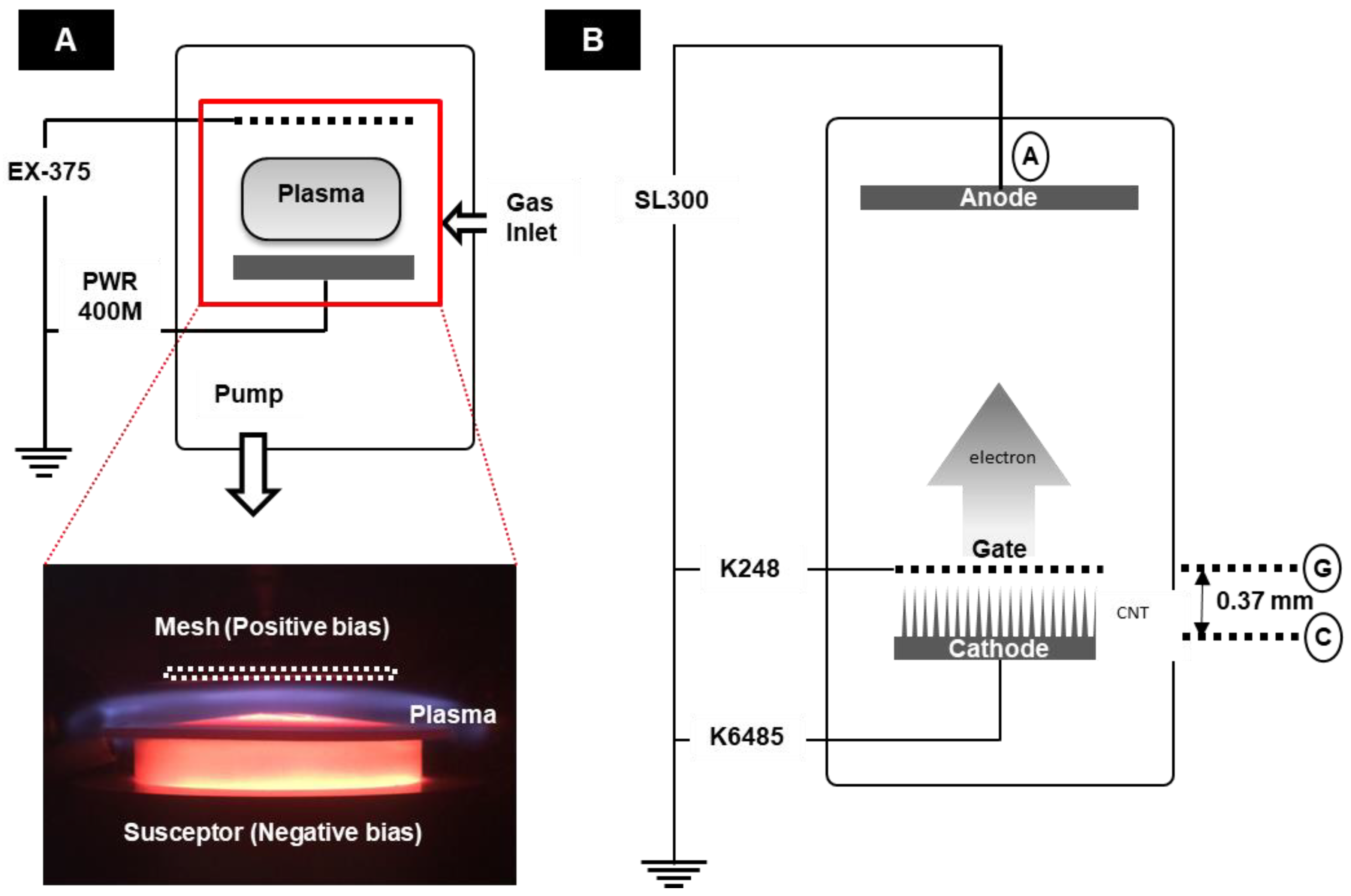
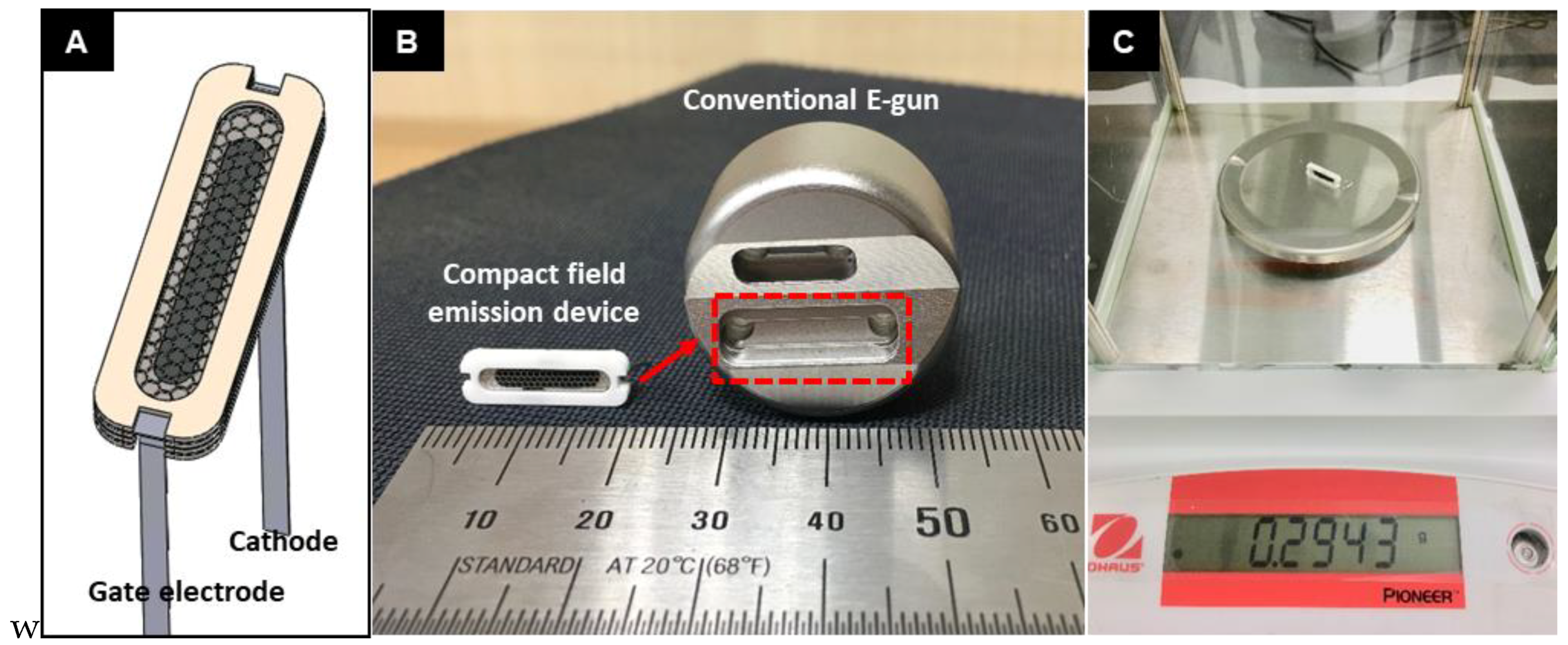
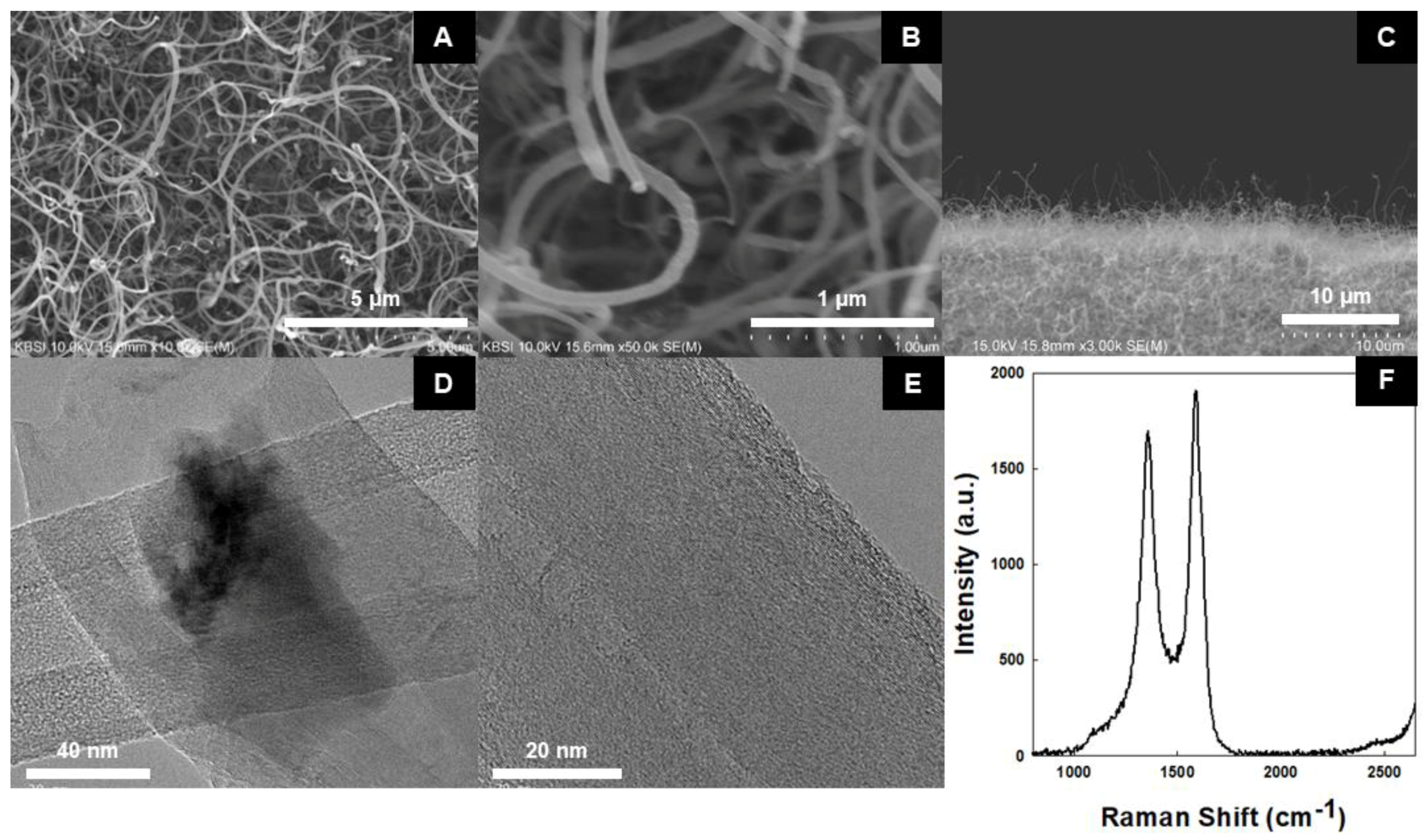
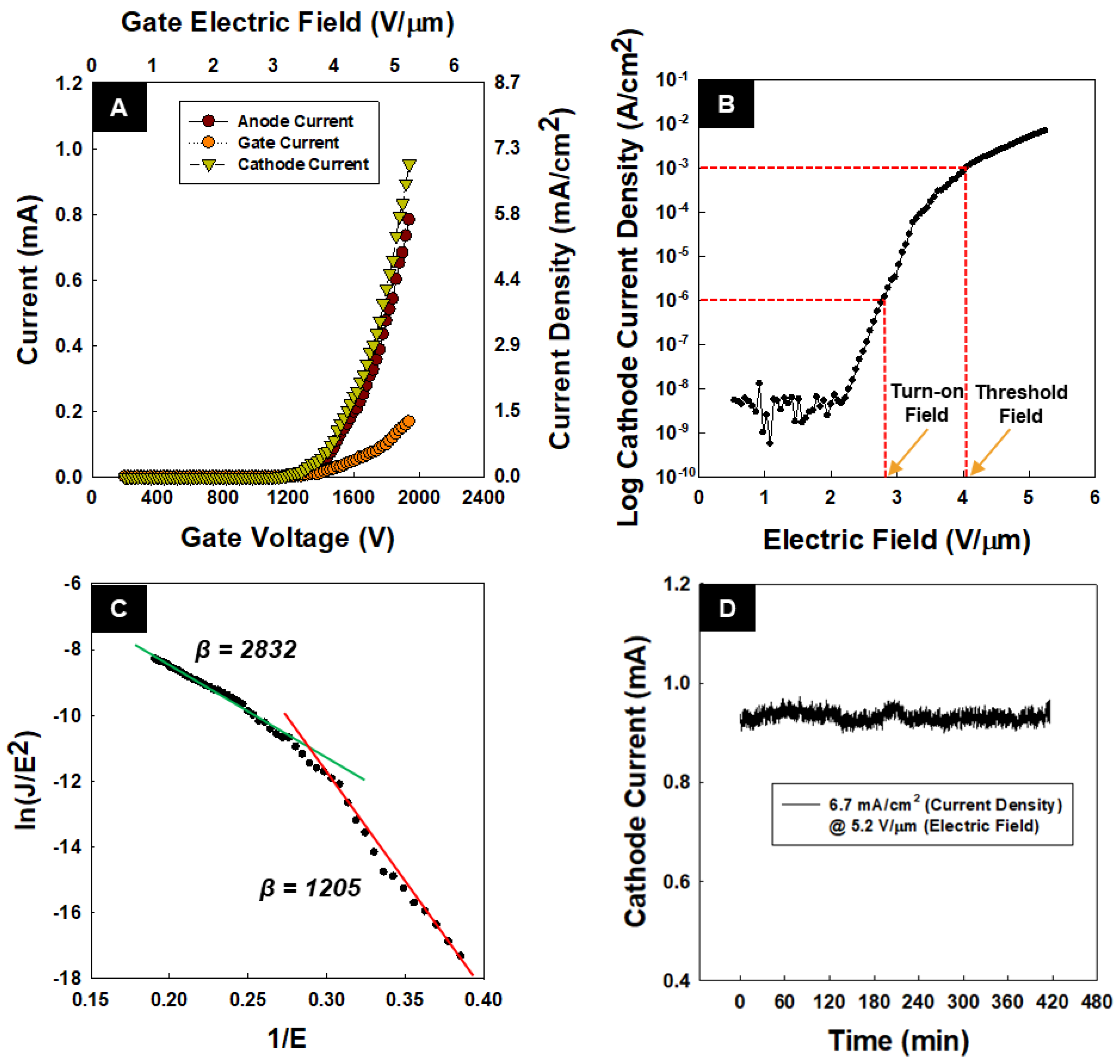
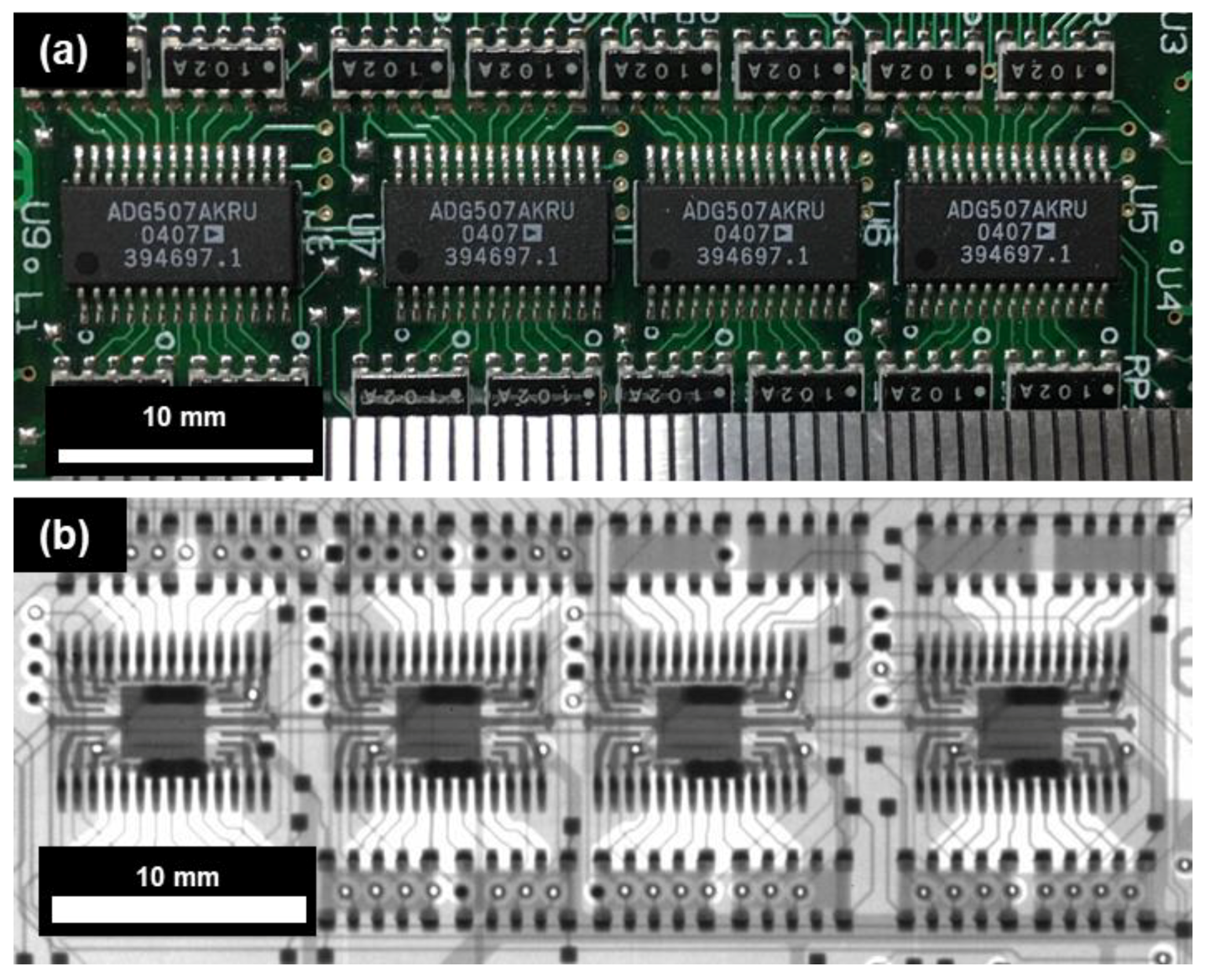
© 2018 by the authors. Licensee MDPI, Basel, Switzerland. This article is an open access article distributed under the terms and conditions of the Creative Commons Attribution (CC BY) license (http://creativecommons.org/licenses/by/4.0/).
Share and Cite
Park, S.; Gupta, A.P.; Yeo, S.J.; Jung, J.; Paik, S.H.; Mativenga, M.; Kim, S.H.; Shin, J.H.; Ahn, J.S.; Ryu, J. Carbon Nanotube Field Emitters Synthesized on Metal Alloy Substrate by PECVD for Customized Compact Field Emission Devices to Be Used in X-Ray Source Applications. Nanomaterials 2018, 8, 378. https://doi.org/10.3390/nano8060378
Park S, Gupta AP, Yeo SJ, Jung J, Paik SH, Mativenga M, Kim SH, Shin JH, Ahn JS, Ryu J. Carbon Nanotube Field Emitters Synthesized on Metal Alloy Substrate by PECVD for Customized Compact Field Emission Devices to Be Used in X-Ray Source Applications. Nanomaterials. 2018; 8(6):378. https://doi.org/10.3390/nano8060378
Chicago/Turabian StylePark, Sangjun, Amar Prasad Gupta, Seung Jun Yeo, Jaeik Jung, Sang Hyun Paik, Mallory Mativenga, Seung Hoon Kim, Ji Hoon Shin, Jeung Sun Ahn, and Jehwang Ryu. 2018. "Carbon Nanotube Field Emitters Synthesized on Metal Alloy Substrate by PECVD for Customized Compact Field Emission Devices to Be Used in X-Ray Source Applications" Nanomaterials 8, no. 6: 378. https://doi.org/10.3390/nano8060378
APA StylePark, S., Gupta, A. P., Yeo, S. J., Jung, J., Paik, S. H., Mativenga, M., Kim, S. H., Shin, J. H., Ahn, J. S., & Ryu, J. (2018). Carbon Nanotube Field Emitters Synthesized on Metal Alloy Substrate by PECVD for Customized Compact Field Emission Devices to Be Used in X-Ray Source Applications. Nanomaterials, 8(6), 378. https://doi.org/10.3390/nano8060378






